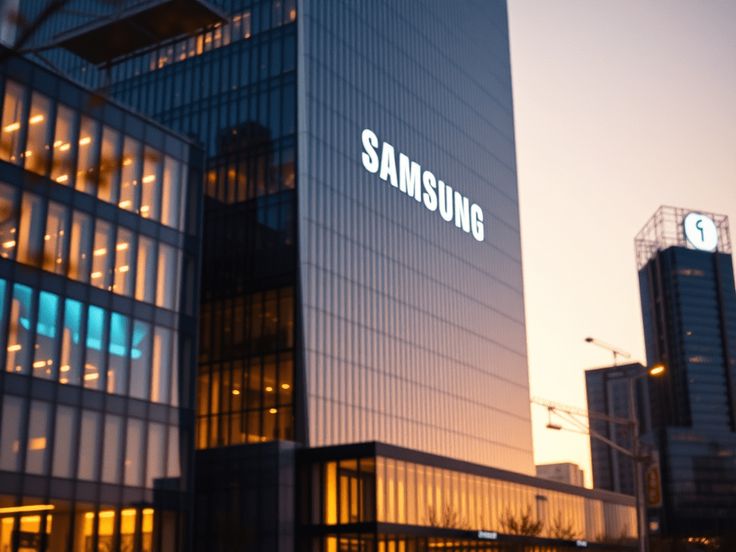
Introduction Samsung: The Making of a Global Samsung Empire
\Founded in 1938 as a modest trading company, Samsung has grown into a $365 billion revenue tech titan (2023 figures). This comprehensive history explores how a company selling dried fish transformed into the manufacturer of 1 in 5 smartphones globally, while leading in semiconductors, displays, and home appliances.
Chapter 1: The Founding Era (1938-1960s) – From Noodles to Nation-Building
1938: Humble Beginnings in Daegu
- Founder Lee Byung-chul starts “Samsung Sanghoe” with 30,000 won ($27 today)
- Initial business: Dried fish, noodles, and produce exports to China
1950s: Post-War Diversification
- 1951: Samsung Moolsan (precursor to Samsung C&T) established
- 1953: Enters sugar refining (Cheil Jedang) and textiles (Cheil Industries)
- Key move: First Korean-owned woolen mill (1954)
1960s: Laying Industrial Foundations
- 1969: Samsung Electronics founded as TV assembler (Joint venture with Sanyo)
- Critical government ties: Park Chung-hee’s industrialization drive
Chapter 2: The Tech Leap (1970s-1990s) – From Copycat to Innovator
1970s: Heavy Industries Push
- 1974: Acquires Korea Semiconductor – foundation for chip business
- 1977: First black-and-white TVs exported to Panama
1980s: Global Aspirations
- 1983: First 64KB DRAM chip – start of memory dominance
- 1987: Founder’s death; Lee Kun-hee takes over, declaring “Change everything but your family”
1990s: Quality Revolution
- 1993: Frankfurt Declaration – burns defective phones publicly
- 1995: “New Management” initiative – $500M quality investment
- Key acquisitions: AST Research (1995), Fokker Aircraft (1996)
Chapter 3: The Digital Age (2000-2010) – Rise to Market Leadership
Mobile Revolution
- 2001: First smartphone (SPH-i300) with Palm OS
- 2009: Galaxy S series launched to counter iPhone
Component Supremacy
- 2002: Becomes world’s largest LCD maker
- 2010: First 30nm DRAM – 2x efficiency boost
Legal Battles
- 2005: $300M price-fixing fine (DRAM cartel)
- 2011: Apple patent war begins (settled 2018)
Chapter 4: The Modern Titan (2010-Present) – Ecosystem Dominance
Smartphone Peak
- 2012: Galaxy S3 – first Samsung phone to outsell iPhone
- 2020: Foldable Z series redefines form factors
Chip Wars
- 2017: Overtakes Intel as world’s largest semiconductor company by revenue
- 2022: First 3nm GAA chips – leads TSMC in advanced nodes
2023 Financial Snapshot
| Division | Revenue | Market Position |
|---|---|---|
| Semiconductors | $63.7B | #1 Memory, #2 Foundry |
| MX (Mobile) | $105B | #1 Android OEM |
| Display | $29B | #1 OLED supplier |
Business Strategy Analysis: How Samsung Wins
1. Vertical Integration
- Controls 90% of the smartphone component supply chain
- From Exynos chips to AMOLED displays – all in-house
2. Bold R&D Spending
- $18B annual R&D budget (3x Apple’s relative to revenue)
- 2023: 6,500+ US patents granted (#2 after IBM)
3. Crisis Management
- 2016 Note7 recall: $5B loss, but brand recovered in 18 months
- 2022 China exit: Shifted production to Vietnam/India
Controversies & Challenges
Governance Issues
- 2017: Lee Jae-yong imprisoned for bribery (pardoned 2022)
- Chaebol reform pressures from the Korean government
Market Threats
- Apple’s custom silicon eroding Android’s premium share
- Chinese rivals (Xiaomi, BOE) in mid-range/lower-margin segments
Future Frontiers: Samsung’s Next Bets
1. AI & Robotics
- Gauss AI (LLM for devices)
- Ballie 2.0 home robot (2025 launch)
2. Advanced Manufacturing
- “Fabs in Space” initiative – semiconductor production in microgravity
3. Green Tech
- 2027 Goal: 100% renewable energy for all global operations
Conclusion: The Paradox of Perpetual Reinvention
From the ashes of war-torn Korea to controlling 20% of South Korea’s GDP, Samsung’s story mirrors the rise of modern Asia. Its future hinges on balancing:
- Technological sovereignty vs global collaboration
- Family control vs corporate transparency
- Hardware dominance vs AI/software transformation
With 429,000 employees across 74 countries, Samsung remains the most comprehensive case study of how to build—and sustain—a tech empire.
Samsung: From Humble Beginnings to Global Tech Dominance – A Complete Historical Analysis
Meta Description: Trace Samsung’s incredible 85-year journey from a small Korean trading company to the world’s largest tech conglomerate. Discover key milestones, business strategies, and future ambitions.
Introduction: The Making of a Global Empire
Founded in 1938 as a modest trading company, Samsung has grown into a $365 billion revenue tech titan (2023 figures). This comprehensive history explores how a company selling dried fish transformed into the manufacturer of 1 in 5 smartphones globally, while leading in semiconductors, displays, and home appliances.
Chapter 1: The Founding Era (1938-1960s) – From Noodles to Nation-Building
1938: Humble Beginnings in Daegu
- Founder Lee Byung-chul starts “Samsung Sanghoe” with 30,000 won ($27 today)
- Initial business: Dried fish, noodles, and produce exports to China
1950s: Post-War Diversification
- 1951: Samsung Moolsan (precursor to Samsung C&T) established
- 1953: Enters sugar refining (Cheil Jedang) and textiles (Cheil Industries)
- Key move: First Korean-owned woolen mill (1954)
1960s: Laying Industrial Foundations
- 1969: Samsung Electronics founded as TV assembler (Joint venture with Sanyo)
- Critical government ties: Park Chung-hee’s industrialization drive
Chapter 2: The Tech Leap (1970s-1990s) – From Copycat to Innovator
1970s: Heavy Industries Push
- 1974: Acquires Korea Semiconductor – foundation for chip business
- 1977: First black-and-white TVs exported to Panama
1980s: Global Aspirations
- 1983: First 64KB DRAM chip – start of memory dominance
- 1987: Founder’s death; Lee Kun-hee takes over, declaring “Change everything but your family”
1990s: Quality Revolution
- 1993: Frankfurt Declaration – burns defective phones publicly
- 1995: “New Management” initiative – $500M quality investment
- Key acquisitions: AST Research (1995), Fokker Aircraft (1996)
Chapter 3: The Digital Age (2000-2010) – Rise to Market Leadership
Mobile Revolution
- 2001: First smartphone (SPH-i300) with Palm OS
- 2009: Galaxy S series launched to counter iPhone
Component Supremacy
- 2002: Becomes world’s largest LCD maker
- 2010: First 30nm DRAM – 2x efficiency boost
Legal Battles
- 2005: $300M price-fixing fine (DRAM cartel)
- 2011: Apple patent war begins (settled 2018)
Chapter 4: The Modern Titan (2010-Present) – Ecosystem Dominance
Smartphone Peak
- 2012: Galaxy S3 – first Samsung phone to outsell iPhone
- 2020: Foldable Z series redefines form factors
Chip Wars
- 2017: Overtakes Intel as world’s largest semiconductor company by revenue
- 2022: First 3nm GAA chips – leads TSMC in advanced nodes
2023 Financial Snapshot
| Division | Revenue | Market Position |
|---|---|---|
| Semiconductors | $63.7B | #1 Memory, #2 Foundry |
| MX (Mobile) | $105B | #1 Android OEM |
| Display | $29B | #1 OLED supplier |
Business Strategy Analysis: How Samsung Wins
1. Vertical Integration
- Controls 90% of the smartphone component supply chain
- From Exynos chips to AMOLED displays – all in-house
2. Bold R&D Spending
- $18B annual R&D budget (3x Apple’s relative to revenue)
- 2023: 6,500+ US patents granted (#2 after IBM)
3. Crisis Management
- 2016 Note7 recall: $5B loss, but brand recovered in 18 months
- 2022 China exit: Shifted production to Vietnam/India
Controversies & Challenges
Governance Issues
- 2017: Lee Jae-yong imprisoned for bribery (pardoned 2022)
- Chaebol reform pressures from the Korean government
Market Threats
- Apple’s custom silicon eroding Android’s premium share
- Chinese rivals (Xiaomi, BOE) in mid-range/lower-margin segments
Future Frontiers: Samsung’s Next Bets
1. AI & Robotics
- Gauss AI (LLM for devices)
- Ballie 2.0 home robot (2025 launch)
2. Advanced Manufacturing
- “Fabs in Space” initiative – semiconductor production in microgravity
3. Green Tech
- 2027 Goal: 100% renewable energy for all global operations
Conclusion: The Paradox of Perpetual Reinvention
From the ashes of war-torn Korea to controlling 20% of South Korea’s GDP, Samsung’s story mirrors the rise of modern Asia. Its future hinges on balancing:
- Technological sovereignty vs global collaboration
- Family control vs corporate transparency
- Hardware dominance vs AI/software transformation
With 429,000 employees across 74 countries, Samsung remains the most comprehensive case study of how to build—and sustain—a tech empire.












